Start of a New Era
|
|
|
|
|







|
|
|
|
|






MARTIN 202A FLEET MARTIN 404 FIEET
|
|||||||||||||||||||||||||||||||||||||||||||||||||||||||||||||||||||||||||||||||||||||||||||||||||||||||||||||||||||
|
|||||||||||||||||||||||||||||||||||||||||||||||||||||||||||||||||||||||||||||||||||||||||||||||||||||||||||||||||||
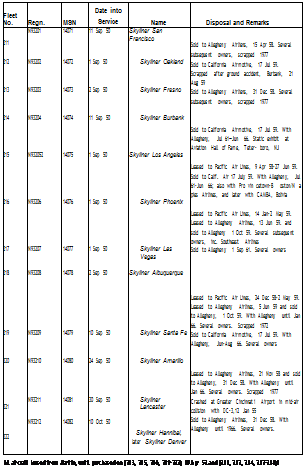 |
|||||||||||||||||||||||||||||||||||||||||||||||||||||||||||||||||||||||||||||||||||||||||||||||||||||||||||||||||||
|
|||||||||||||||||||||||||||||||||||||||||||||||||||||||||||||||||||||||||||||||||||||||||||||||||||||||||||||||||||
|
|||||||||||||||||||||||||||||||||||||||||||||||||||||||||||||||||||||||||||||||||||||||||||||||||||||||||||||||||||
|
LOCKHEED TRISTAR FLEET |
|
Delayed Debut (or the L-1011 The advent of the Boeing 747 wide-bodied airliner stimulated a surge of airline traffic growth throughout the world and across the United States. The potential market encouraged other manufacturers to add more wide-bodied types (8-10 abreast seating instead of 6). For the short-haul, the twin-engined European Airbus was to make its mark, and the traditional adversaries of piston-engined times entered the field. Douglas and Lockheed both offered tri-jet candidates that were quite similar in design. The former was quickly off the mark, and its DC-10 went into service with American Airlines on 5 August 1971. |
|
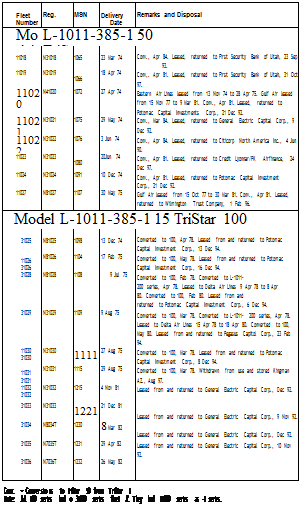
|
The L-10U TriStar, N31001, shows the revised ‘outlined’ TRANS WORLD marking. |






 |
Lockheed was handicapped by its engine manufacturer, Rolls-Royce, coming face-to-face with financial ruin (its shares dropped briefly to one penny) and was saved from oblivion only by intervention by the British government. Production of the Lockheed L-1011 TriStar was in abeyance for many months. Then, on 29 March 1968, the program was launched in grand style, with a total order book for 144 aircraft, of which T. W.A.’s share was 44, but the uncertainties were such that the eventual firm order date was 7 May 1971. T. W.A. TriStar service started on 25 June 1972.
|
|
COMPARISON OF L-1011 VARIANTS UP BY TWA
14 seats » 190 mph
|
|
the unique douglas вс-в
|
One of the early DC-2s poses for the camera. |
Tine Douglas DC-1
Only nine months after the $125,000 contract was signed, the Douglas DC-1 made its first flight on 1 July 1933, and was delivered to T. W.A. On 13 September. Jack Frye and Paul Richter flew it to Kansas City, 1,450 miles, averaging 205 mph. The airline operated the unique DC-1 for a few years, even on a few scheduled services, then it was sold to Howard Hughes in January 1936. It eventually passed to Lord Forbes in England, and finished up as a military transport during the Spanish Civil War in 1938. It crashed at Malaga in December, 1940.
The Douglas DC-2
The DC-1 had 12 seats, two more than the 247’s 10; but T. W.A. and Douglas quickly realized that by adding two more feet to the fuselage, this could be improved to 14. The resulting Douglas DC-2 first flew on 11 May 1934, went into service one week later, and the world of airlines was never the same again. It chased the 247s off the main-line U. S. airways, and when, on 1 August 1934, T. W.A. introduced it on the transcontinental “Sky Chief’ service, Jack Frye was more than vindicated in his vigorous initiative. A new era of airline service began, and as early as September, the Ford Tri-Motors were retired, to be used as freighters, or, in one unusual case, to be used as a floatplane ferry service in New York (page 44).
 |


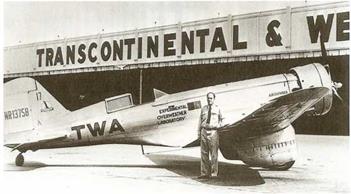
The Northrop Alpha
Jack Northrop left Lockheed, and started his own company, at El Segundo, California, to build his first high-speed aircraft, which incorporated all-metal construction, stressed skin for the wings, and a monocoque fuselage, together with other aerodynamic improvements, such as engine cowling and wing fillets. The main objective was to save weight; but it also improved the strength; and Northrop’s innovations became standard practice. T. W.A. introduced the Northrop Alpha in April 1931. It was a beautiful aircraft, and used only for mail. As indicated in the table below, it must have been difficult for the pilots to handle.
The Lockheed Orion
The wooden Vega (see page 36) was quickly superseded by the metal Lockheed Orion, the first airliner in the world to exceed 200 mph. It was welcomed especially by airlines that competed with the Ford operators, and captured the public imagination with the publicity value of speed.
The Orion was the first aircraft to employ flaps, to reduce speed on descent and landing. Nevertheless, its survival rate was not as good as the new generations of multiengined all-metal Douglas and Boeing modern airliners.
The Consolidated Fleetster
Also appearing in the early 1930s was the neat Consolidated Fleetster, a high-winged monoplane, with clean lines and a speed of 150 mph. But it carried only six passengers, and was used sparingly by T. W.A. Like the Condor, it was recognizably, in the light of the Boeing 247 and Douglas DC-2 that came on the scene in 1933-34, the last of the generation of airplanes that had been outpaced by the explosive growth of air transport in the early 1930s.
Swan Song
The use of single-engined transport airplanes ended quite abruptly. Their record was not encouraging; and the conditions of the McNary-Watres Act ensured their speedy retirement front the commercial airways.
NORTHROP FLEET
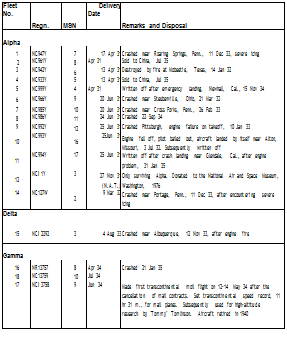

![]()
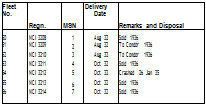 “Tommy” Tomlinson, one of the great experimental test pilots of the 1930s,
“Tommy” Tomlinson, one of the great experimental test pilots of the 1930s,
is seen here with the Northrop Gamma which he used to demonstrate
“over-the-weather” flying. This led to the introduction of pressurized
airliners, the first 307s (see page 44).
|
|
In contrast with Northrop’s low wing and Lockheed’s high wing design,
Ruben Fleet’s was unusual. At least the pilot had a good view.
40 seats • 280 mph
9 AIRCRAFT
|
|
The 404 differed visually from its 202 predecessor by the addition of one extra cabin window, and the absence of the cockpit ‘eyebrow’ window.
|
||||||||||||||||||||||||||||||||||||||||||
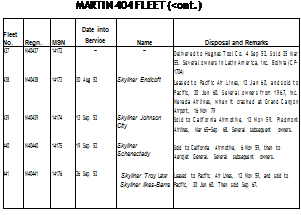 |
||||||||||||||||||||||||||||||||||||||||||
|
||||||||||||||||||||||||||||||||||||||||||
|
||||||||||||||||||||||||||||||||||||||||||

Tomorrow the World…
The astonishing success of the Constellation and Howard Hughes’s association with it was followed by the award of overseas routes to Europe (page 50). T. W.A. had won its spurs across the Atlantic Ocean during the Second World War (page 50). When the airline industry adjusted itself to postwar conditions, the airline consolidated its transcontinental network, and entered the world’s most competitive air route: between northeast U. S.A. and western Europe. After opening its first Atlantic service to Paris on 5 February 1946 (page 50), T. W.A.’s rapidly-expanding Constellation fleet was soon to be seen in many of the capitals of Europe and as far as the Middle East. T. W.A. reached Bombay on 5 January 1947, and Colombo by the summer of 1953. The aircraft carried the slogan Trans World Airline, and this was formally registered as the new name for T. W.A. On 17 May 1950.
On 25 April 1956, the C. A.B. Examiner approved an extension from Colombo onwards to Bangkok and Manila, where the line would connect with Northwest’s trans-Pacific terminal. This would complete the round-the-world service— and challenge Pan American for that achievement. Service opened on 1 October, but was terminated in April 1959, because of dismal load factors on the eastern segments.
Much Changing of the Guard
Still controlling T. W.A.’s fortunes, Howard Hughes was, by this time, facing dissatisfaction within his top management, much of it of his own making. He was increasingly diverted by other interests, mostly of the feminine gender, leaving the day-to-day management to others. In February 1947, his long-time flying associate, Jack Frye, resigned, and took with him chairman T. B. Wilson, and executive vice-president Paul Richter, who dated back to Frye’s Standard Air Lines days in 1929. Lamotte Cohu became president, but effectively Hughes’s oil-drilling giant, Toolco, took control. Cohu resigned on 1 June 1948, and Warren Lee Pierson took over.
Things settled down when Ralph Damon was elected president on 25 January 1949. Damon came with formidable credentials (page 61) and for a few years, on Hughes’s behalf, he kept the T. W.A. ship on an even keel. They made a good team, and when Damon died of pneumonia on 4 January 1956, T. W.A. went through an uncertain period. Carter Burgess became president on 23 January 1957, but he did not last long, resigning on 8 December 1957, and Warren Lee
Pierson took over once again, only to hand over to Charles S, Thomas on 15 July 1958.
Bracing for the Jets
In spite of the problems of top management, and pilots’ strikes in 1946 and 1947, the airline made steady improvement, matching the competition both within the States and across the Atlantic. On 1 July 1947, Constellations began a transcontinental night service, with only only stop; at Chicago, in an eastbound journey time of just over ten hours. On 1 October 1948, the “New York Sky Chief’ and “Paris Sky Chief’ all-sleeper luxury service opened on the Atlantic route. De Luxe service Super Constellations, starting on 10 September 1952, reduced the transcontinental journey time further, and then, on 19 October 1953, the “Ambassador” service offered eastbound non-stop flights in 8 hours. On 1 June 1957, this was consolidated with Lockheed 1649A Star – liner service. In November 1955, the celebrated Denver Case, decided by the Civil Aeronautics Board, gave T. W.A. the authority to stop at Denver en route from Chicago to San Francisco. Overseas, T. W.A. opened a direct Polar Service from California to London on 29 September 1957.
While the airlines were still emphasizing luxury and creature comforts, the balance of air travelling public was changing. The dominance of business travel was giving way to a growing tourist and leisure market. On 1 April 1952, all the members of the quasi-cartel IATA (International Air Transport Association) introduced Tourist-Class fares across the Atlantic; and this was followed by Economy Class on 1 April 1958. As an IATA member, T. W.A. kept pace with the changing fare structures.
Storm Clouds
Possibly because T. W.A. had lost, by Damon’s death, an accomplished administrator who could steer it through rough waters, the airline ran into difficulties during the late 1950s. In spite of continued traffic growth and increases in fleet strength, T. W.A. lagged behind in the queue to buy jet aircraft. Pan American Airways had set the world of airlines into a spin on 13 October 1955, when it ordered 20 Boeing 707s and 25 Douglas DC-8s, to launch the Jet Age in earnest (after the British de Havilland Comet had set the pace in 1952, but had paid the price with structural problems). Hughes finally ordered 8 Boeing 707-I20s in February 1956, but showed his preference elsewhere. He ordered 30 Convair
880s (at first called the 600 Skylark), in June of that year, ignoring the other established manufacturers of big airliners, Douglas and Lockheed.
There was a brief flirtation with the long-range Bristol Britannia turboprop (page 59), but the jets were inevitable, and Hughes ordered 25 more Boeing 707s in May 1957. However, the finances were such that even Toolco, once the almost limitless source of capital, needed help. It came from the insurance giant, Equitable Life, which insisted on a longterm financing plan. This was to have long-term repercussions on the fortunes of the multi-millionaire owner.
T. W.A. Takes a Gamble
But the show went on. In spite of a company-wide strike in November 1958, the first Boeing 707 was received on 17 March 1959, and put into service only three days later. Facing transcontinental competition from American Airlines, which had started jet service coast-to-coast on 25 January 1959, T. W.A. took a gamble. It operated its New York-San Francisco route for a whole month with only one aircraft; and the fact that that N732TW held out, without a single cancellation, was a great tribute to its engineering staff at Kansas City.
They could never have done it with even the best of the piston-engined airliners. An inspection, at least, would have been necessary, possibly an engine change. But the 707’s Pratt & Whitneys held out.
|
This 707 is seen here climbing out over the entrance to San Francisco Bay. |
|

Artist’s Note
The legendary Raymond Loewy designed T. W. A.’s elegant new ‘arrowhead’ cheatline. Pilots were quoted as saying “The jet looked like it was going 600 mph on the ground!"
The Jet Age Begins
The jet engine, invented by Hans von Ohain in Germany and Sir Frank Whittle in England during the 1930s, was not operational until the closing stages of the Second World War. Most aviation authorities considered that their use would be only for military types because the fuel consumption rate was excessive. But in England, the de Havilland Comet, which first flew in 1949 and went into service with B. O.A. C. in 1952, proved otherwise. The airliner had structural deficiencies, which led to its withdrawal in 1954, but it did prove the viability of jet airliners in commercial service. The fuel consumption of engines that were designed for economy, not absolute performance, was lower than expected; and the fuel—kerosene, not gasoline— was cheaper. Most important, and not fully realized until the Comet’s service record revealed it, was that the turbine engines did not suffer from the wear and tear of the reciprocating piston – engines; and nor did they have the complication of propellers. The TBO (Time Between Overhaul) of the jets grew in unbelievable leaps and bounds; and the positive effect was also observed in the airframes, where rivets stopped popping as excessive vibration ceased.
The United States Takes Over
Americans have always been superb in developing a good idea, whether or not it was invented or innovated at home or abroad. This has nowhere been truer than with jet airliners. Only a few short months after the pioneering Comet was grounded, the Boeing 367-80 made its first flight on 15 July 1954. Little more than a year later, on 13 October 1955, in the order that shook the aviation world, Pan American Airways ordered 45 ‘big’ jets, 20 Boeing 707s and 25 DC-8s. T. W.A.’s first order was placed on 7 February 1956.
The impact of the Jet Age, when first, the B. O.A. C. de Havilland Comet 4 started Atlantic service on 4 October 1958, and Pan Am followed on 26 October, was overwhelming. The Boeing 707 was twice as fast and twice as big as its piston-engined predecessors, so that the productivity was four times as great. Yet the world air traffic demand kept pace, thanks to the introduction of economy fares. The Jet Age had begun, and transformed the world of air transport.
|
Engines |
Pratt & Whitney JT3C-6 (13,500 lb. thrust) x 4 |
Length |
145 feet |
|
N1GT0W |
247,000 lbs |
Span |
131 feet |
|
Range |
3,000 miles |
Height |
42 feet |
|
T. W.A. had four Boeing 720s. This variant of the Boeing 707 was 8 feet shorter than the -100 series, with 14 fewer seats. |
 |
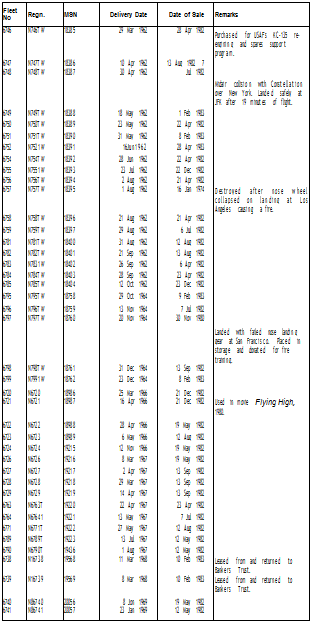


BOEING 707-131
|
Fleet No. |
Regn. |
MSN |
Delivery Dat |
> Date of Sale |
Remarks |
|
7731 |
N731TW |
17658 |
8 Jul 1959 |
3 Dec 1971 |
|
|
7732 |
N732TW |
17659 |
17 Mar 1959 |
1 Dec 1971 |
|
|
7733 |
N733TW |
17660 |
30 Mar 1959 |
2 Nov 1971 |
|
|
7734 |
N734TW N16648 |
17661 |
3 Apr 1959 |
9 Dec 1974 |
Sold to Carbourne Corp., 20 Dec 1971. Repossessed and reregistered, 15 Jan 1973. Sold to Israel Jan 1975. |
|
7735 |
N735TW |
17662 |
18 Apr 1959 |
8 Mar 1971 |
Sold to Air International. |
|
7736 |
N736TW |
17663 |
29 Apr 1959 |
8 Dec 1971 |
|
|
7737 |
N737TW |
17664 |
10 May 1959 |
15 Dec 1971 |
Hijacked to Shannon, 1 Nov 1969. |
|
7738 |
N738TW |
17665 |
13 May 1959 |
17 Dec 1971 |
|
|
7739 |
N739TW |
17666 |
28 May 1959 |
19 Dec 1971 |
|
|
7740 |
N7401W |
17667 |
28 May 1959 |
11 Dec 1971 |
|
|
7741 |
N741TW N16649 |
17668 |
13Jun 1959 |
9 Dec 1974 |
Sold to Carbourne Corp., 20 Dec 1971. Reregistered and repossessed, 15 Jan 1973. Sold to Israel Jan 1975. |
|
7742 |
N742TW |
17669 |
1 Jul 1959 |
6 Nov 1967 |
Destroyed by fire after aborted takeoff from Cincinnati. |
|
7743 |
N7431W |
17670 |
10 Jul 1959 |
22 Apr 1970 |
Destroyed by fire on the ground at Indianapolis. |
|
7744 |
N744TW |
17671 |
14 Jul 1959 |
25 Nov 1971 |
|
|
7745 |
N7451W |
17672 |
1 Aug 1959 |
28 Nov 1971 |
All purchased by Hughes Tool Co. (Toolco) (N731TW – N745TW) and leased to T. W.A. at $2,500 per day. Except where noted, all aircraft sold to Israel Aircraft Industries (IAI)
BOEING 707-124
All Boeing 707-124s ex-Continental Airlines, sold to Israel Aircraft Industries.
* All Boeing 707-13 IB aircraft (N746TW – N86741) sold to Boeing Military Airplane Co., except where noted.
*Two more 707-131Bs, 6760/N760TW (18398) & 6780 N780TW (18399) ordered but cancelled and not built.
BOEING 707-13IB*
This eye-catching painting by artist Ren Wicks, captures the glamour of the early jet age, with a T. W.A. Boeing 707flying (a little off the designated approach path) over the center of Paris.
|
|
LOCKHEED 1329 JETSTAR 6

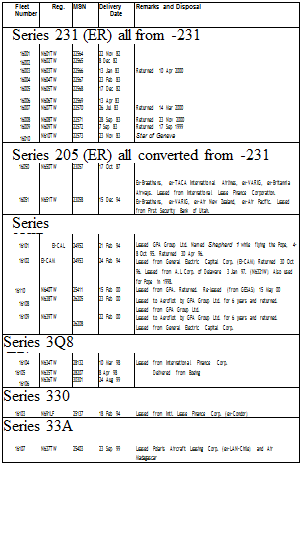
The Two-Man Crew
During the 1970s, the number of crew on the flight deck had become an important issue, not only because of the elimination of radio officers, navigators, and engineers per se, but because reducing the statutory number from three to two had a significant effect on the operating costs. Four or five complete crews are required to operate an airliner that is being worked at a high utilization rate, so that the airlines encouraged any move towards reducing crew expenses. In the USA, Douglas had initiated the practice with its DC-9s and Boeing followed with the 737s.
The 767 is Launched
Production of the Boeing 767 began when United Airlines placed an order on 14 July 1978. The first flight was on 26 September 1981, and United put it into service on 8 September 1982. During the development period, the F. A.A. was still conducting trials for two-crew operations, following the con
clusions of a presidential task force, announced in July 1981. In fact, the first 767s off the line were retrofitted for two – crew, as Boeing had had to go ahead with the then current regulatory limitations. The first two-crew flight deck made its initial flight on 27 May 1982 — just in time for United’s inaugural — and a versatile new airliner generation was bom.
Outstanding Success
The 767 was outstandingly successful. It proved its worth — thanks largely to the two-crew factor — operationally and economically, on all routes, short-haul, medium-haul, and long – haul. Its prowess in this last category, in which the reliability of the engines exceeded all expectations, led to serious thoughts as to the possibility of using it for trans-ocean operations.
ETOPS (originally EROPS-extended range…)
In May 1985, the F. A.A. approved the Boeing 767 for Extended Twin-Engine Operations (ETOPS) of up to 120
minutes from an alternate airport. The program was so successful that in March 1989, the 767 was approved for a
180-minute diversion. This was a far cry from the late 1960s, when airliners could not even fly in a straight line from New York to Miami, because of the distance from an alternate airport for part of that route. ETOPS was one of the most important developments in the history of air transport, with thoughts of so-called “four-engined safety” long forgotten, overtaken by technology.
BOEING 767 FLEET
6 seats • 150 mph
6 seats • 180 mph
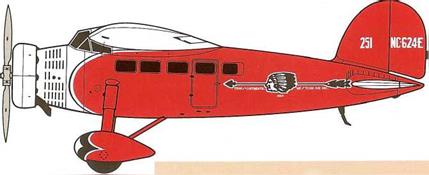


VEGAS
Engine Pratt & Whitney Wasp (420 hp) MGTOW 4,2171b.
Range 600 miles
Length 27 feet
Span 41 feet
ШСКНЕІІ SINGLE-ENGIMSD FLEET
|
Fleet |
Delivery |
|||
|
No. |
Regn. |
MSN |
Date |
Remarks and Disposal |
|
Vega L-l |
NC6525 |
9 |
Jul 28 |
Type 1, converted to 5C. Used by Maddux Air Lines for charter work, especially for motion picture companies. Sold after accident at San |
|
Diego mid-1929 |
||||
|
L-2 |
NC7044 |
11 |
Aug 28 |
Type 1, converted to use R-685 engine. Also with Maddux until merger with T. A.T. Sold 1930 and used by several owners. Flown as a "rum runner" from Oklahoma to neighboring "dry" states. |
|
Scrapped 1952. |
||||
|
251 |
NC624E |
53 |
11 Dec 31 (into service) |
Type 5. Sold to Hanford’s Tri-State Airlines. |
|
253 |
NC497H |
135 |
1931 |
Type DL-1B. Built by Detroit Aircraft Corp. Written off, 31 Jan 34, after forced landing, St. James, Missouri |
|
254 |
NC288W |
137 |
1932 |
Type DL-1B. Sold to Hanford’s 1934 |
|
255 |
NC483M |
136 |
Mar 32 |
Type DL-1 B. Sold to Varney Speed Lines, 24 Jul 34 |
|
Altair BL-2A |
||||
|
252 |
NCI 2222 |
180 |
Sep 1931 |
Leased from manufacturer. Crashed at Columbus, Ohio, 10 Oct 31. Subsequently many owners, including Paul Mantz. Unservicable after 1965 |
|
Orion 9E |
||||
|
256 |
NCI 2277 |
192 |
11 May 33 (into service) |
Crashed into Missouri River, Kansas City, 28 Jul 33 |
|
257 |
NCI 2278 |
193 |
11 May 33 |
Crashed near Albuqueque, 15 Jan 34 |
|
258 |
NCI 2283 |
195 |
11 May 33 |
Withdrawn from service, Feb 35 |
Faster Mail
T. W.A. had a few Vegas from the end of 1931, but used them mainly for mail, as the DC-2s soon made them redundant. Even so, Lockheed was establishing a reputation for building fast aircraft, and in 1933, Air Express, Inc., was operating a speedy transcontinental mail and express service, at first with Vegas, but even more successfully with Orions (see page 37).
|
The Lockheed Vega was the first of several single-engined, mainly wooden, Lockheed types that, for a short time (until the introduction of the Douglas DC-2) carried the transcontinental air mail faster than the Ford Tri-Motors. |
The Urge for Speed
During the late 1920s, the contrast between the speed of racing airplanes and the slow, 100 mph (on a good day) Fords was becoming more evident, as the former types improved every year. Designed by John K. Northrop, the Lockheed Vega offered a practical compromise. Built of wood, and efficiently streamlined, it could fly much faster than the Ford, and could—unlike the racers—carry six passengers. Also, it cost only $17,500. The airline authority, Edward P. Warner, estimated that the better speed compensated for the smaller size, so that the operating costs per seat-mile were about the same as the Ford’s.
|
The Lockheed Orion was the metal-built development of the original Vega. It is seen here during the winter of 1933/34 with, in the rear, a Northrop Alpha. |
![]()
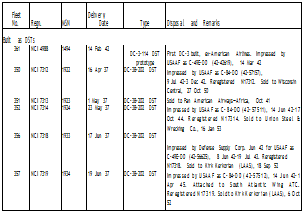
 A World-Beater
A World-Beater
The Douglas DC-2 had been an instant success, surpassing all other transport aircraft in performance and offering an unprecedented standard of airliner comfort. It had achieved everlasting fame when the Dutch airline, K. L.M., entered it for the England-Australia Air Race in October 1934, and to the astonishment of the world, came in second, among a field of specially-designed racing and sporting aircraft. Moreover, it carried four passengers and a load of mail, and stopped at all the K. L.M. stations along the route. This led to export orders for Douglas, to Europe, Australia, and to China.
The DST
While T. W.A.’s Tommy Tomlinson was conducting his experiments with the Northrop Gamma (see page 37) in search of faster and smoother high-altitude flight “above the weather,” one of the rival transcontinental airlines was concentrating on other directions of competitive rivalry and excellence. Bill Littlewood, of American Airlines, recommended the development of the Douglas DC-2 by widening the fuselage, not only to make room for 14 bunk beds, but also to accommodate three abreast seating instead of two (21 v. 14). The first Douglas DST went into service between New York and Chicago on 25 June 1936; and a dramatic new era had begun.
Interestingly, this first service was as a dayplane, but the aircraft fulfilled its original design purpose when American received its first Douglas DC-3 and the transcontinental skysleeper service began on 18 September 1936.
The Great DC-3
With its fleet of 31 DC-2s, T. W.A. had less need for the larger Douglas DC-3 than did the other U. S. airlines. United Air Lines, for example, in spite of its close Boeing heritage, had to buy the Douglas flagship, and introduced it between Los Angeles and San Francisco on 1 January 1937. It followed with a luxury 14-seat daytime service on New York-Chicago in February, and then put the DST on its transcontinental route in July.
The DST, as Donald Douglas had warned, did not meet with the outstanding success that had been predicted; but the DC-3 exceeded all expectations. American’s president, C. R. Smith, claimed that it was the first airliner to be able to make a profit without the benefit of air mail payments. This was with the equivalent of today’s first-class fare levels and no doubt with every seat filled; but it was nevertheless a measure of its overwhelming superiority. It became, in various versions, the standard transport aircraft for the U. S. and
Allied forces in the Second World War; and was built under license in the Soviet Union and Japan. Of all types, 10,926 were built in the United States, 487 in Japan, and 6,157 (as Lisunov Li-2s) in the Soviet Union.
T. W.A/S DC-3s
Jack Frye had to supplement his DC-2 fleet with the more efficient DC-3s. The first one, a DST, entered service from New York to Los Angeles on 1 June 1937. Dayplanes were also
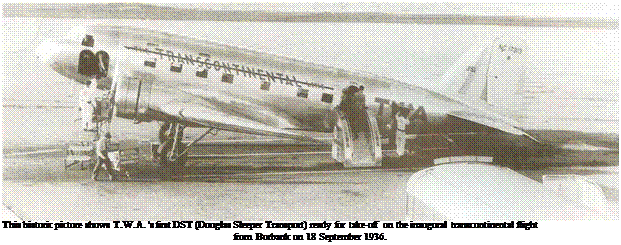 added on all routes during that summer, and the addition of the extra capacity could not have come at a better time. T. W.A. gained more direct access to San Francisco from Winslow, via Las Vegas; and restored its link with Chicago from Dayton, via Fort Wayne. The old “Gooney Bird” served T. W.A. well before, during, and after the War. The fleet list, spread over this and the next two pages, totalled 104 aircraft, of which 14 were DSTs, 34 DC-3s, 12 military C-49s (conversions of DC-3s), and 43 military C-47s and C-53s (postwar converted DC-3s).
added on all routes during that summer, and the addition of the extra capacity could not have come at a better time. T. W.A. gained more direct access to San Francisco from Winslow, via Las Vegas; and restored its link with Chicago from Dayton, via Fort Wayne. The old “Gooney Bird” served T. W.A. well before, during, and after the War. The fleet list, spread over this and the next two pages, totalled 104 aircraft, of which 14 were DSTs, 34 DC-3s, 12 military C-49s (conversions of DC-3s), and 43 military C-47s and C-53s (postwar converted DC-3s).
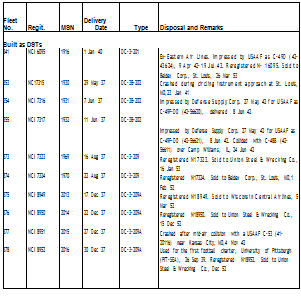
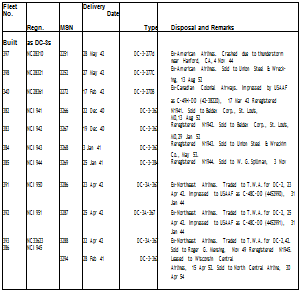
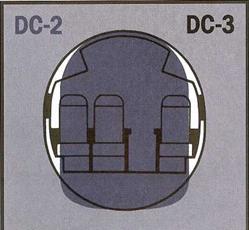 |

![]()
 |
DOUGLAS B£»3 FLEE! LIST (ronfsaued)
In airliner development, the fuselages are invariably lengthened.
The transition from DC-2 to DC-3 was an exception—and an
aerodynamic improvement.
|
||||||||||||||||||||||||||||||||||||||||||||||||||||||||||||||||||||||||||||||||||||||||||||||||||||||||||||||||||||||||||||||||||||||||||||||||||||||||||||||||||||||||||||||||||||||
 |
||||||||||||||||||||||||||||||||||||||||||||||||||||||||||||||||||||||||||||||||||||||||||||||||||||||||||||||||||||||||||||||||||||||||||||||||||||||||||||||||||||||||||||||||||||||
 |
||||||||||||||||||||||||||||||||||||||||||||||||||||||||||||||||||||||||||||||||||||||||||||||||||||||||||||||||||||||||||||||||||||||||||||||||||||||||||||||||||||||||||||||||||||||
|
||||||||||||||||||||||||||||||||||||||||||||||||||||||||||||||||||||||||||||||||||||||||||||||||||||||||||||||||||||||||||||||||||||||||||||||||||||||||||||||||||||||||||||||||||||||
|
||||||||||||||||||||||||||||||||||||||||||||||||||||||||||||||||||||||||||||||||||||||||||||||||||||||||||||||||||||||||||||||||||||||||||||||||||||||||||||||||||||||||||||||||||||||


 DC-1 (length 60 feet)
DC-1 (length 60 feet)
The DC-1 (and the DC-2) were distinguished from the later aircraft by the narrow, flat-sided fuselage, and small vertical stabilizer. The DC-1 had six cabin windows per side. Powered by two 650-hp Wright Cyclone engines, it was a giant airplane for its day (see pages 33-35).
DC-2 (length 62 feet)
The DC-2 added one more cabin window to each side. Engine horsepower was improved to 800 hp, and larger landing lights were added to the nosecone. All other structural details were quite similar to those of the DC-1 (see pages 34-35).
 BST/OC-3 (length 64.5 feet)
BST/OC-3 (length 64.5 feet)
The DST had a longer and wider cabin, with one more window added to the DC-3 version, and an eighth cabin window on the left side of the aircraft for the DST. Most noticeable feature of the ‘sleeper’ DST was the small horizontal “bunk” windows above the main window line (see pages 38-40).

C-47 (length 64 feet)
The most abundantly produced version of the DC-3 family, this military aircraft was considered by General Eisenhower to be one of the most essential pieces of machinery of the Second World War. Note the addition of cowl flaps, highly modified engine nacelles and tailcone, and a glass ‘astrodome, ’ through which navigators took celestial and solar sightings.
N73ITW
unnonmrmnoomon поооооооооОооп’ОдооздппгГГкпопа
This picture epitomizes the beginning of the Jet Age. T. W.A.’s Boeing 707-131 N731TW is pictured on the ramp at San Francisco early in 1959, and parked next to a United Air Lines Douglas DC-7, symbol of a former era. The handsome airport building does not yet have the air bridge
connection, and the crew stands ready with the mobile staircase.
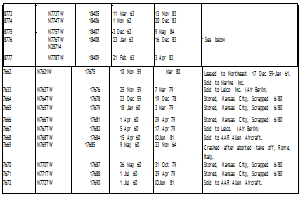
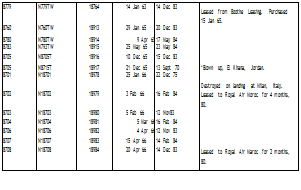
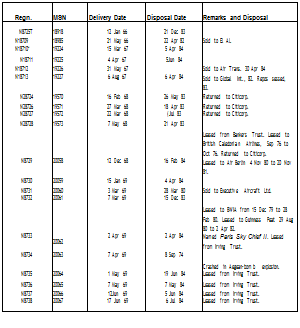


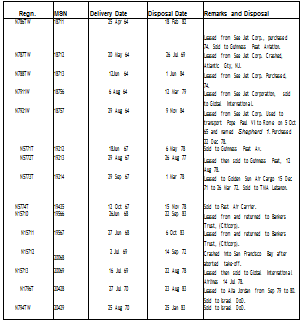

‘ Nomed London Town and inaugurated Idlewild—Heathrow – Frankfurt service, 23 Nov 1959.
BOEING 707-33IB
(All aircraft sold to Boeing Military Airplane Co.)
* Cockpit was destroyed by a bomb in Damascus 29 Aug 69. New nose section built by Boeing and transported to Damascus ond installed. Reregistered as N28714 24 Dec 69 after threats to destroy tbe same aircraft were made.
BOEING 707-33IB (A)
(Except where noted, all sold to Boeing Military Airplane Co.) * Hijacked from Frankfurt, Germany 6 Sep 70.
* Flew JFK – O’Hare-Kansas City as T. W.A.’s last commercial 707 flight, 31 Oct 83.
BOEING 707-373C (H)
BOEING 707-338C (H)
BOEING 720-05IB
This Boeing 707-33IB (Advanced) had the new ‘outlined’
TRANS WORLD marking, and a revised logo style on the tail.
|
|
|
|


The 707 “Intercontinental” had a longer fuselage, larger improved wing, taller vertical fin, and a ventral fin below the tail. Note the ‘blow-in doors’ on the “Dyna-Fan” engine nacelles’ forward section.
Progressive Improvement
With the 707 series, Boeing became the world’s leader in airliner manufacturing. The classic Boeing 707 came in several forms. Initially, the -100 was a comfortable transcontinental airliner, but was limited across the Atlantic, having to stop at Gander or Shannon in the westbound direction. Its Pratt & Whitney JT4A-9 straight jet engines were known, rather unkindly, as the “Ole Smokies.” The -300, with JT3Cs and a slightly longer fuselage, was much better, and the -300B with JT3D turbofans and improved wing better still. The -331B(A-H) (Advanced – Heavy) had a heavy-duty landing gear, allowing a gross take-off weight up to 335,000 lb. They had more range, more capacity, and were more profitable than previous versions. The greater power enabled the -300 to be able to cut about half a mile from the take-off distance required by the other Boeings.
T. W.A.’s Decision
Having demonstrated considerable ingenuity and initiative, not to mention technical confidence, in launching its transcontinental jet service with a single Boeing 707-131 on 20 March 1959 (page 67). T. W.A. did not rush immediately to match Pan American on the trans-Atlantic route. It elected to await the availability of the longer-ranged -331, and meanwhile concentrated on expanding its domestic network so that T. W.A. Boeings were competing with American’s at all the major cities. Ultimately, the -331s were deployed on the New York-London-Frankfurt route on 23 November 1959. T. W.A. had lost a whole year to its archrival Pan American, and with other problems of a non-technical or operational nature, the airline had a long fight on its hands.
Engines Pratt & Whitney JT3D-3 (18,000 lb. thrust) x 4 Length 153 feet
MGT0W 335,0001b Span 146 feet
Range 4,000 miles Height 42 feet
|
|
The Smaller Boeings
To meet a requirement for routes of lower traffic density, Boeing produced a shorter-bodied version, the 720, 8 feet shorter than the -100, but with the same wing. T. W.A. also had one Series -138, which was 10 feet shorter than the basic type, and designed for the Australian airline QANTAS, with extra tankage for maximum trans-Pacific range. T. W.A. operated a total of 133 Boeing 707s, and made good use of them all over the world.


 |
T. W.A. introduced the Boeing 767 on the Los Angeles-Washington route on 2 December 1982. The first of the Douglas DC-9-80s (MD-80s) entered service on 3 May the next year, and on 31 October 1983, the last T. W.A. Boeing 707 made its final flight from New York to Kansas City. The airline expanded its route system but in February 1984, it once again became a separate corporation and, in a deteriorating financial situation, T. W.A. tightened its belt (see page 90).
Another T. W.A. First
Nevertheless, and possibly overshadowing these events in a wider airline context, was another claim to firstliness that T. W.A. could add to its already impressive list of such pioneering events. On 1 February 1985, it became the first U. S. airline to fly a twin-engined airliner, the Boeing 767, across the Atlantic in scheduled passenger service. This was under the EROPS program certificated by the F. A.A. (See page 88). Today, more Boeing 767s fly across the Atlantic than all the other aircraft types combined — and many of the latter are twin-engined too.
|
|
TWA’s 767 VARIANTS
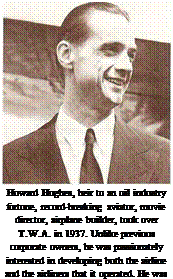
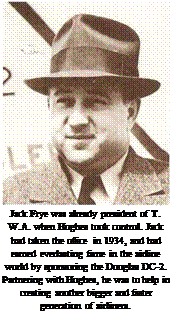 Enter Howard Hughes
Enter Howard Hughes
After Charles Lindbergh, and sharing fame with Amelia Earhart, Howard Hughes was America’s most famous aviator personality in the 1930s. He was admired by the public, respected by politicians who were aware of the power of his wealth, and recognized by the aviation community for his achievements. His wealth had been inherited from his parents who had died in the early 1920s, and at the age of 18 he began to expand the family business, the Hughes Tool Company, which held close to a monopoly of oil drilling bits.
Tlie Phenomenon
Taking to the business world like a duck to water—one commentator said that he ran his entire operation “out of his hip pocket for nearly 40 years”—he worked hard and played hard. He made films, including such epics as Scarface, Hell’s Angels, and The Outlaw. He romanced movie stars and flew airplanes. Everything he did was at the highest level of attainment, and this included his flying activities. Having won the Sportsman’s Trophy in 1934, he founded the Hughes Aircraft Company and built—and flew—a racing airplane, the H-l, and beat the world’s landplane speed record in 1935. The following year, in a Northrop Gamma, he broke the transcontinental speed record, and in 1937 broke it again, in his H-l. In this latter case, he flew at an altitude of 14,000 feet, using oxygen, and received the Harmon Trophy. In July 1938, in a Lockheed 14, he flew around the world in less than four days, averaging 202 mph. He had made meticulous preparations, and demonstrated systems of radio communication, weather reporting, and navigation that were in advance of their time. The aircraft was known as The Flying Laboratory,’ and for this flight, he received the Collier Trophy from President Roosevelt himself.
Into the Airline Fray
Howard came into the airline industry, therefore, with impressive credentials. By 1937, T. W.A. had passed out of the control by the Pennsylvania Railroad and North American Aviation (by the conditions of the 1934 Air Mail legislation) and was owned by Yellow Cabs’ John Hertz and Lehman Brothers, the investment bankers. T. W.A. President, Jack Frye, did not apparently like the control and approached Hughes with a view to starting another airline, which Hughes would finance and Frye would manage. Howard had another idea. In April 1939 he bought 25% of T. W.A. stock and by 1940 had increased this to a dominating 78%. He took over a great airline and set about the task of making it even better.
|
|
This picture epitomizes the tremendous impetus given to the United States airline industry during the latter 1930s. The busy scene can be contrasted with that of what was then a modern airport in the late 1920s (page 19), only a decade earlier. The DC-3 was truly the first transport airplane that could be called a modern airliner; and but for T. W.A. it might never have happened.